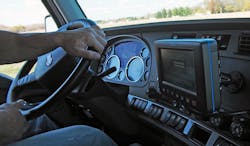ELD mandate: A business burden or technology upgrade?
Ready or not, by Dec. 18, 2017, most commercial truck drivers will be required to use electronic logging devices (ELDs) to record their hours of service. For carriers, that means driver retention and productivity challenges lie ahead.
The key for fleets to overcome some of those challenges includes embracing early adoption and figuring out how to maximize the business benefits of ELDs rather than viewing the mandate as a regulatory burden. That’s at least according to Eric Starks, CEO and chairman of FTR Intelligence.
“The regulations are going to create a bigger driver shortage than we would normally see at this point in time in the economic cycle,” Starks explained during a recent Fleet Owner webinar entitled Maximizing the business benefits of ELDs.
[For a link to that webinar, click here.]
One of the issues for carriers is how to keep drivers productive, Starks noted. The other part of the challenge is trying to understand productivity.
“What we find is when we have a loss in productivity, that tends to tighten capacity,” Starks said. “So what we’re seeing right now is things are likely to tighten.”
“What this is telling us is that as we start looking at implementation of electronic logging devices, we start having a productivity loss somewhere in the ballpark of around 4% for the overall industry,” he continued. “And that tightens capacity noticeably.”
Starks noted, however, that there is a disconnect between those that have the wherewithal and the ability to make the change early. Typically, the impact for businesses that have already converted to ELDs is not nearly as significant as those that are likely to convert going forward.
He explained that the loss of productivity for early adopters of ELDs is somewhere in the ballpark of 5% to7%. Conversely, those that adopt later are likely to see an impact of upwards of 10% in productivity loss.
Getting the most out of ELDs
What’s your mind-set when it comes to adopting ELDs? Is it that this is a required regulation? Is it that this is a loss of productivity? Is it seen as a business burden? Is it seen as an expense? Do you have unhappy drivers?
According to Starks, a fleet’s mind-set is a big deal and influences how it will approach adopting ELD solutions.
“If you change your mind-set and you say you know what, ‘I am going to see that it could be a technology upgrade, it could be one of exploring big data, it gives me better information, it allows me to maximize my driver and equipment’ – If you approach it that way, then your solution for electronic logging devices changes because now you’re approaching it rather than begrudgingly saying this is something I have to do,” Starks explained.
“This is now saying, ‘I’m willing to embrace this and now I’m willing to move forward," he said. "I think I can enhance my business practices better than I ever could before.’”
In order to get the most out of these devices, Starks noted that fleets must first determine what they need the ELD data to do for them, for instance help maximize better utilization of equipment, track driver hours, note when something is askew, track productivity and dispatch communications, etc.
“Typically, we find people aren’t using the information they already have,” Starks explained. “You need to be able to understand the information you have at your fingertips first and foremost.”
Starks suggested taking baby steps and having a targeted outcome based on your fleet’s needs. He also urged carriers to bring in a service provider rather than setting up the devices in-house.
“Look at this as a technology upgrade and your ability to now go to the next level,” he urged. “It changes your perception 100%. What you need to do is find a partner solution to do this. But can you communicate effectively what you need? Prioritize some of the needs that you have, and talk to others that are starting to utilize the system.”
JJ Singh, CEO of EKA Solutions, has been involved with ELDs since 2010, and he said he is well aware of the challenges trucking companies have faced since day one.
Noting that opportunities abound beyond simply complying with the mandate, Singh said some of the basic benefits of ELDs include:
- Location tracking (GPS) – improved asset and driver productivity
- Idle time – lower fuel costs; driver behavior events – improved safety, lower claims
- Engine fault codes – improved maintenance
- Digital driver/dispatch communication – improved productivity
Beyond that, Singh discussed a fleet he recently worked with that chose a Telogis solution to provide more enhanced benefits. The platform he discussed uses an 8-in. tablet in the cab for the drivers to use, allowing for better driver-vehicle inspection reports (DVIR). The fleet also found that its DVIR workflow improved when it came time for vehicle repairs and maintenance. Singh added the solution uses motion and time and tells fleet managers whether or not their driver really walked around the vehicle to conduct exams.
“You’ll find out that you’re more in compliance because if you use that process, it is more likely than not that you will have that work done and less likely to have an out-of-service situation if you’re stopped on the highway,” Singh explained.
Another benefit of ELDs is geofencing, Singh noted. With geofencing, fleet managers are alerted when their drivers and vehicles arrive at locations, which helps them more accurately measure detention. According to Singh, additional advanced benefits include:
- Third-generation routing capabilities that offer embedded tools that guide drivers safely to the route
- Scanning image documents – Drivers can take images of documents and send them back to third-party vendors and to the fleet
- Rate drivers based on driver incidents
- A reduction in costs, particularly when using tablets
- Track loads and truck movement
- Reduce claims and risk exposure
“You really have to decide what’s important for you and what you want to get out of the solutions,” Singh said. “It depends on what you want to do first. It’s important to think about which telematics vendors you want to look at for serious consideration.”
Shippers and enforcement
According to Starks, the biggest issue for shippers regarding the ELD mandate is making sure they have plenty of capacity. Plus, they’re worried about the looming deadline, he said.
“They are saying, ‘If you don’t have an ELD device, I will not do business with you – now or ever,’” Starks stressed. “I think that is really a push to get carriers to do it.”“We don’t know what the real implementation will look like for ELDs,” he added. “What [shippers] don’t want is for everybody at the very end to implement ELDs. But what does enforcement look like? You’ll have some carriers that say, ‘You know what I’m going to risk it.’ And shippers don’t want that, they want continuity.”
And when it comes to the often contentious issue of detention time, ELDs might end up being the answer for both shippers and carriers.
“How aggressive will [carriers] be with coming down on the shipper because now you have facts in real-time in front of you,” Starks stressed. “Carriers can say here’s how much you held up my equipment and driver to the shipper and here’s how much you owe me. I have data in my possession, here it is, and here’s how much you owe me. Truckers are very skittish to do that.”
Singh added that the biggest advancement in this case is having access to objective, transparent information in real time.
As for enforcement efforts, there are still too many unknowns. Starks said he expects that early on enforcement will be pretty straightforward and that there will be a bit of a grace period while the industry adjusts. He did note, however, that enforcement could come back to the states, and they will determine how aggressive their efforts will be.
“If I was a carrier, it would almost be irrelevant to me because I wouldn’t want to pay those penalties and take the risk,” Starks explained. “Regardless, you’re going to have to convert. If it were me, I would have already been working through this process by now to give myself some wiggle room.”
Singh also noted that most inspectors – state and federal – know where the soft points are within the data, and that the FMCSA uses devices to transfer data from the ELD into their system. He added that inspectors will be looking for the last seven to eight days of logs during a vehicle stop and roadside inspections.
“If implementation of enforcement is pretty strong, you would push a lot of people off the road for a period of time, and that truck and that driver wouldn’t be on the road for a long period of time,” Starks said. “That could create a big problem for ELDs.”
About the Author

Cristina Commendatore
Cristina Commendatore is a past FleetOwner editor-in-chief. She wrote for the publication from 2015 to 2023.


